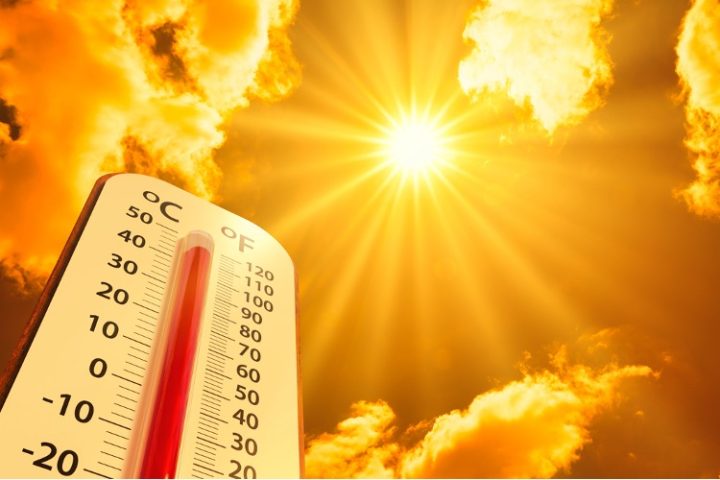
According to a brand-new study published by the Proceedings of the National Academy of Sciences this week, large portions of the most densely populated parts of the planet, including much of the eastern and central United States, may be rendered uninhabitable or nearly so within a few decades, as a consequence of anthropogenic global warming projected through the year 2100.
Reckoning in terms of so-called wet-bulb temperatures — a measure of temperature in terms of the human body’s capacity to thermoregulate — as little as a 1.5° Celsius rise in average global temperatures would result in significant temperature increases in parts of Sub-Saharan Africa, the Indian Subcontinent, and southeastern China. With a 3° Celsius increase, the affected areas would not only broaden in Africa and Asia, they would also begin to crop up in South America and south-central United States. A 4° Celsius rise would create a hot zone in most of the eastern United States, at least as far north as New York and Chicago.
Since climate scientists are predicting as much as a 6° Celsius rise in the annual global temperature by 2100, these latest findings have caught the attention of the mainstream news media. Noted Newsweek:
There are some instances where incredibly hot temperatures have already started to affect humans. Scientists reiterate that while models used in the study are good at predicting events, they do not predict specific events. Events like this can include the Oregon heatwave that killed more than 700 people in 2021. It also does not seem possible that humans will be able to adapt to these rapidly rising temperatures.
And according to The Washington Post,
The research underscores how the most severe impacts of climate change will be felt in countries that have done the least to create it, said Fahad Saeed, a Pakistan-based climate scientist with the German think tank Climate Analytics. It shows much of the worst and most lasting heat occurring in densely populated and underdeveloped parts of southern and southeastern Asia and Africa. And while data has shown massive death tolls from heat waves in Europe, for example, the toll of the impacts in those hardest-hit regions is likely dramatically underestimated because of a lack of research and reporting, Saeed said.
According to traditional wisdom, at a wet-bulb temperature of 35° Celsius (roughly 95° Fahrenheit with 100-percent humidity), the human body is no longer able to stay cool, because sweat can no longer evaporate fast enough to stop the internal temperature from rising. More recent studies have suggested that this temperature may, in fact, be as low as 31° Celsius. Anyone who has ever experienced humid tropical conditions, with air temperatures in the upper 80s or low 90s but with 100-percent humidity, is familiar with these conditions and their effects: heat rash, prickly heat, headaches, and eventual heatstroke. Such stretches of intolerable hot and humid conditions are reckoned by the authors of the study in terms of “hot hours”; by later this century, they claim, large portions of the world’s most densely populated regions, as well as half of the continental United States, may experience hundreds of hot-hours annually, possibly leading to massive die-offs.
All of this is ascribed to anthropogenic climate change, only reversible by concerted and robust global measures to contain and eventually reverse it. Having lived in and travelled extensively to several of the areas outside the United States cited in this study, this author can attest to the fact that the heat and humidity of the American tropics, the Indian Subcontinent, and southern China are indeed an assault on the senses. For those unaccustomed to its rigors, only staying within air-conditioned enclaves will stave off the misery of extreme heat and humidity, and the physical debilitation it can cause.
Nevertheless, humans have adapted to living in extreme heat conditions since well before the onset of the industrial age. When the British and other European colonial powers arrived in India, for example, they found most of the population living in the torrid lowlands, despite the availability, all over the region, of high hills and mountain ranges, from the Himalayas in the north to the Western Ghats and Nilgiri Hills in the south. The British lost no time building up “hill stations” in all of these areas to escape the heat, many of which quickly took on the character of English exclaves complete with vegetable gardens and fruit orchards. Today these locations are favored vacation spots — but the overwhelming majority of the Indian, Pakistani, Bangladeshi, and Sri Lankan populations continue to live in the lowlands, where summertime (pre-monsoon) temperatures routinely soar far above 100° Fahrenheit, with stifling humidity to boot.
More curious still is the millennia-long climate change which has severely altered the climate of the Subcontinent, while doing little to render the region uninhabitable. Four millennia ago, the Indus River Valley (which is mentioned by name in the PNAS study) was the site of a flourishing urban civilization, the largest by geographical extent of the Bronze Age. Centered on the Indus and Sarasvati River system in what is now Pakistan, the civilization benefited from an entire network of rivers and a warm, rainy climate similar to what is found in northeastern India and southeast Asia today, thousands of miles to the east of the Indus Valley. We know this because, among other things, Indus artifacts are covered with the images of animals such as the one-horned rhinoceros and the Indian elephant, animals that live only in the humid tropics with abundant forests, marshes, and other water sources. Nothing remotely like those conditions is found anywhere today in Pakistan, Afghanistan, and northwest India. Most of the rivers once plied by boats of the Indus Civilization are dried up, and the once-lush forests and marshlands have transformed into arid thornscrub. No elephant or rhino has lived there within historical memory. In other words, the entire region has become desert over several thousand years, presumably as a consequence of the long-term warming and drying of the earth’s climate following the last Ice Age.
Yet much of that desert remains densely populated. And while many of the people of India and Pakistan might prefer cooler temperatures, their entire culture has evolved to accommodate the annual heat followed by the life-giving monsoons. And none of this was in any way precipitated by man-made climate change.
None of which is to say that the prospect of more or longer heat waves is necessarily something to look forward to. But it is to say that, despite the cocksure pronouncements of today’s climate-science claque, the mechanisms of climate change, their relationship to human activity, and human adaptability to such changes are still poorly understood. Modern industrialization is humanity’s most ingenious effort yet to overcome the many ravages imposed on the human condition by an unfeeling Mother Nature, including disease, extreme heat and cold, flooding, famine, and the like. As a result of modern technology, natural famine and many once-desolating diseases such as smallpox have been eliminated, and the quality of living has increased dramatically for most of the world’s population.
Are we now to set all these things aside, and to submit to a comprehensive new global regime curtailing much of the critical technology that makes the modern world possible, because of the possibility (uncertain at best) that future generations may be inconvenienced by warmer weather that is already the rule in large parts of the world?



